maintenance CHEVROLET SUBURBAN 1994 Owners Manual
[x] Cancel search | Manufacturer: CHEVROLET, Model Year: 1994, Model line: SUBURBAN, Model: CHEVROLET SUBURBAN 1994Pages: 385, PDF Size: 19.88 MB
Page 2 of 385
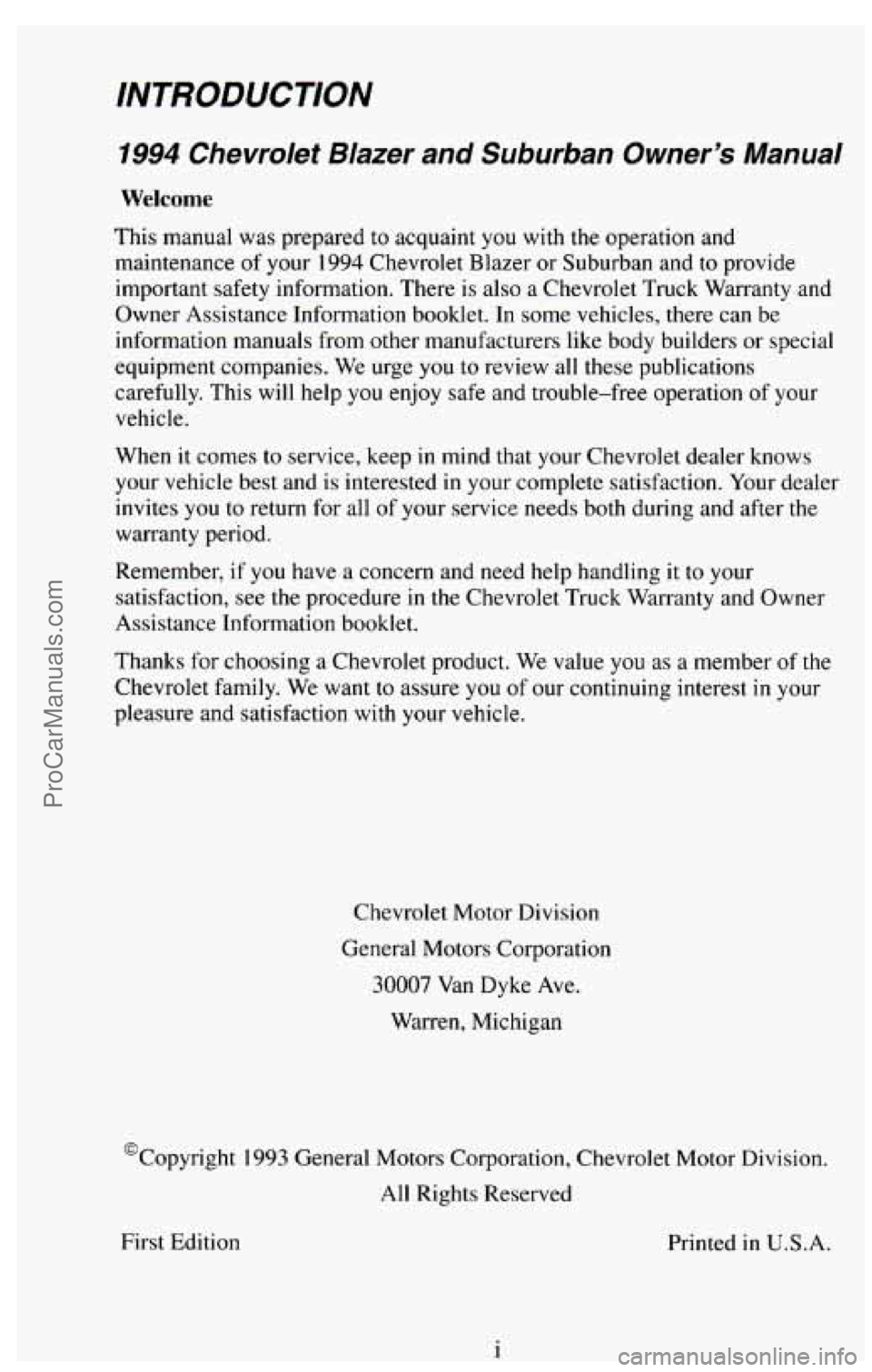
INTRODUCTION
1994 Chevrolet Blazer and Suburban Owner’s Manual
Welcome
This manual was prepared to acquaint you with the operation and
maintenance
of your 1994 Chevrolet Blazer or Suburban and to provide
important safety information. There
is also a Chevrolet Truck Warranty and
Owner Assistance Information booklet.
In some vehicles, there can be
information manuals from other manufacturers like body builders or special
equipment companies. We urge you
to review all these publications
carefully. This will help
you enjoy safe and trouble-free operation of your
vehicle.
When it comes
to service, keep in mind that your Chevrolet dealer knows
your vehicle best and is interested in your complete satisfaction. Your dealer
invites you to return for all of your service needs both during and after the
warranty period.
Remember, if
you have a concern ana need help handling it to your
satisfaction, see the procedure in
the Chevrolet Truck Warranty and Owner
Assistance Information booklet.
Thanks for choosing a Chevrolet product. We value
you as a member of the
Chevrolet family. We want to assure you of our continuing interest
in your
pleasure and satisfaction with your vehicle.
Chwrolet Motor Division
General Motors Corporation
30007 Van Dyke Ave.
Warren, Michigan
@Copyright
1993 General Motors Corporation, Chevrolet Motor Division.
All Rights Reserved
First Edition
i Printed
in U.S.A.
ProCarManuals.com
Page 5 of 385
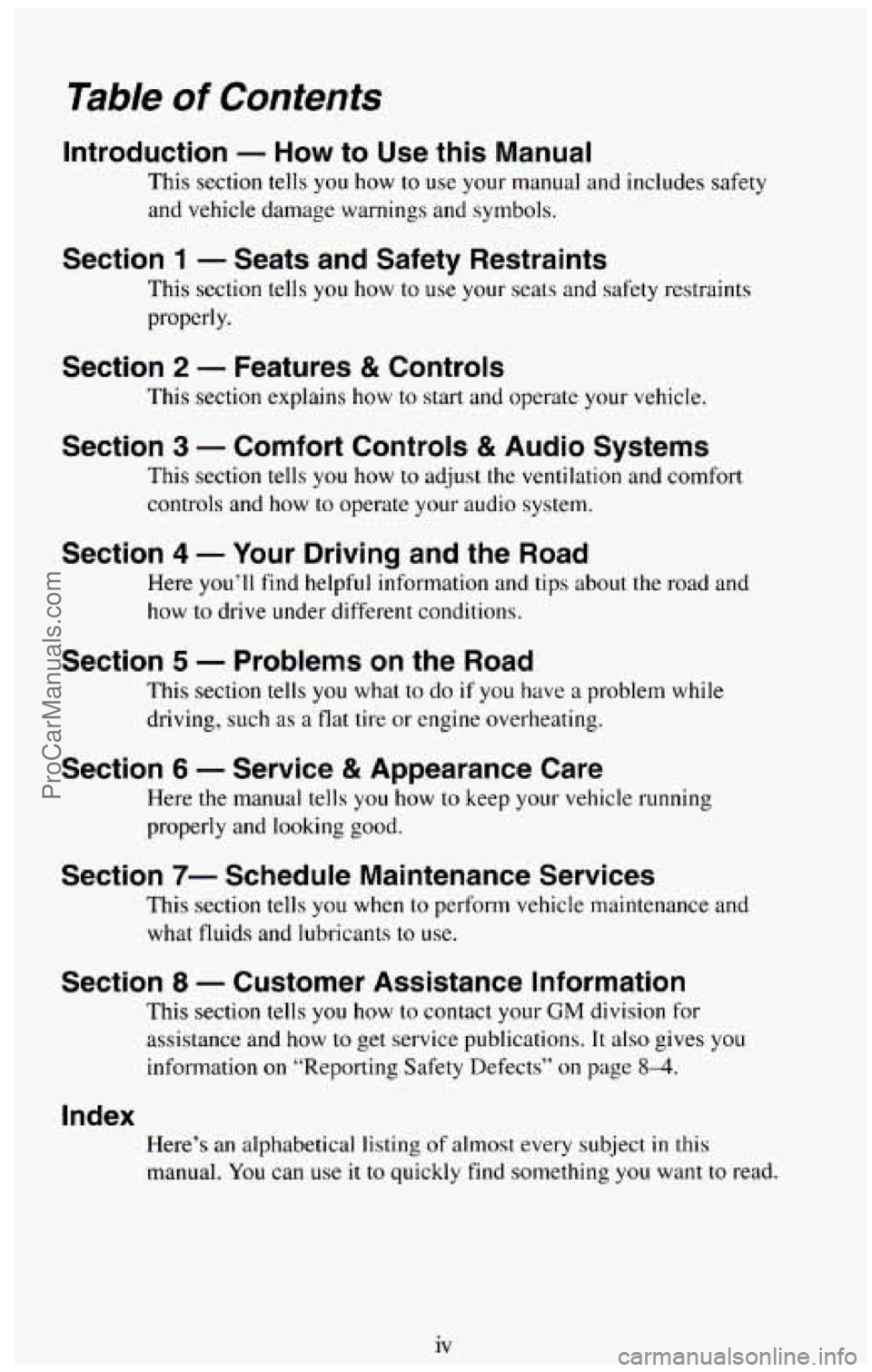
Table of Contents
Introduction - How to Use this Manual
This section tells you how to use your manual and includes safety
and vehicle damage warnings and symbols.
Section 1 - Seats and Safety Restraints
This section tells you how to use your seats and safety restraints
properly.
Section 2 - Features & Controls
This section explains how to start and operate your vehicle.
Section 3 - Comfort Controls & Audio Systems
This section tells you how to adjust the ventilation and comfort
controls and how to operate your audio system.
Section 4 - Your Driving and the Road
Here you’ll find helpful information and tips about the road and
how to drive under different conditions.
Section 5 - Problems on the Road
This section tells you what to do if you have a problem while
driving,
such as a flat tire or engine overheating.
Section 6 - Service & Appearance Care
Here the manual tells you how to keep your vehicle running
properly and looking good.
Section 7- Schedule Maintenance Services
This section tells you when to perform vehicle maintenance and
what fluids and lubricants to use,
Section 8 - Customer Assistance Information
This section tells you how to contact your GM division for
assistance and
how to get service publications. It also gives you
information on “Reporting Safety Defects” on page 8-4.
Index
Here’s an alphabetical listing of almost every subject in this
manual. You can use it
to quickly find something you want to read.
iv
ProCarManuals.com
Page 6 of 385
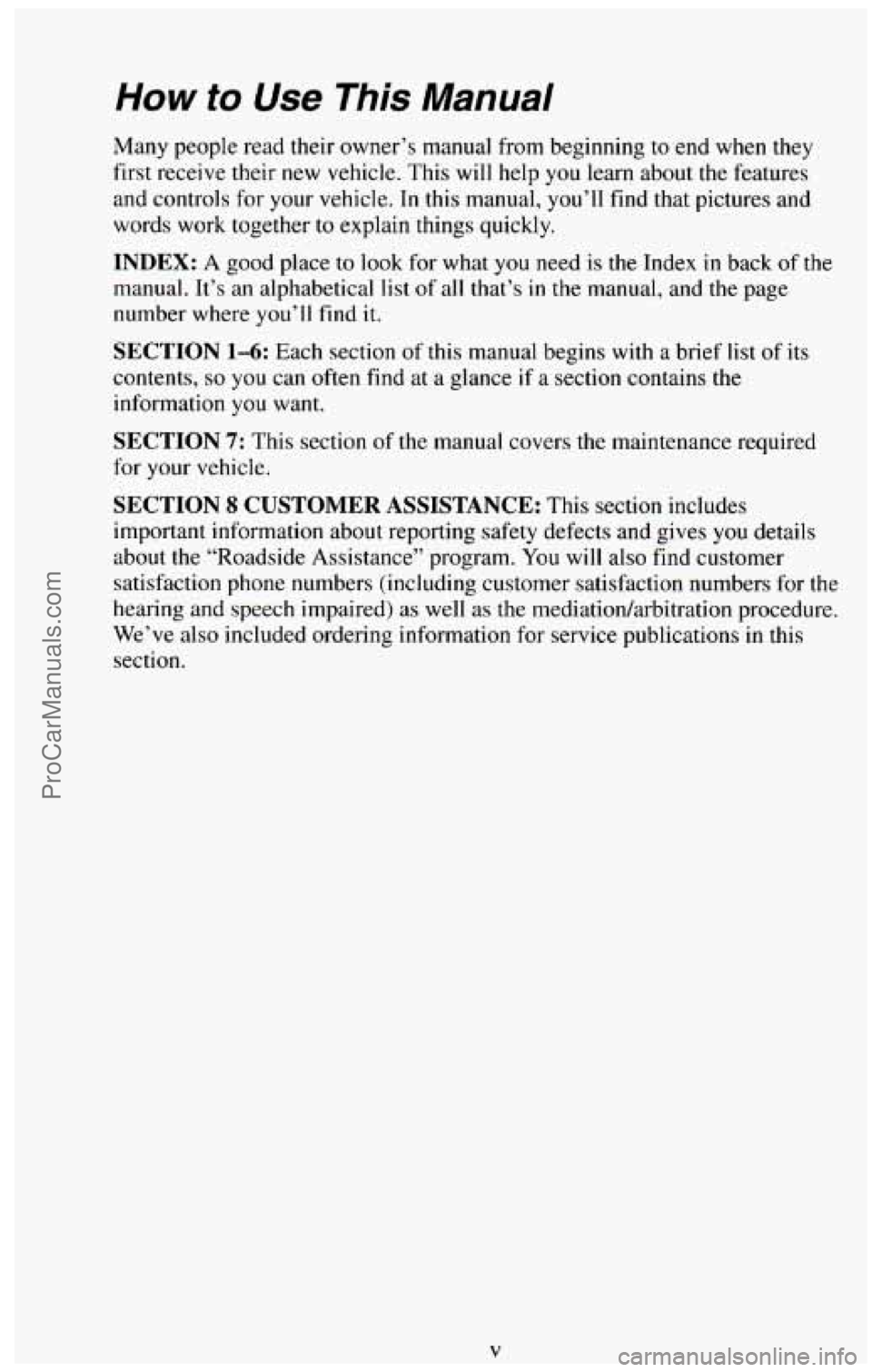
How to Use This Manual
Many people read their owner’s manual from beginning to end when they
first receive their new vehicle. This will help you learn about the features
and controls for your vehicle. In this manual, you’ll
find that pictures and
words work together
to explain things quickly.
INDEX: A good place to look for what you need is the Index in back of the
manual. It’s an alphabetical list of all that’s
in the manual, and the page
number where you’ll find
it.
SECTION 1-6: Each section of this manual begins with a brief list of its
contents, so you can often find at a glance if a section contains the
information you want.
SECTION 7: This section of the manual covers the maintenance required
for your vehicle.
SECTION 8 CUSTOMER ASSISTANCE: This section includes
important information about reporting safety defects and gives
you details
about the “Roadside Assistance’’ program.
You will also find customer
satisfaction phone numbers (including customer satisfaction numbers for the
hearing and speech impaired) as well as the mediatiodarbitration procedure.
We’ve also included ordering information for service publications
in this
section.
ProCarManuals.com
Page 159 of 385
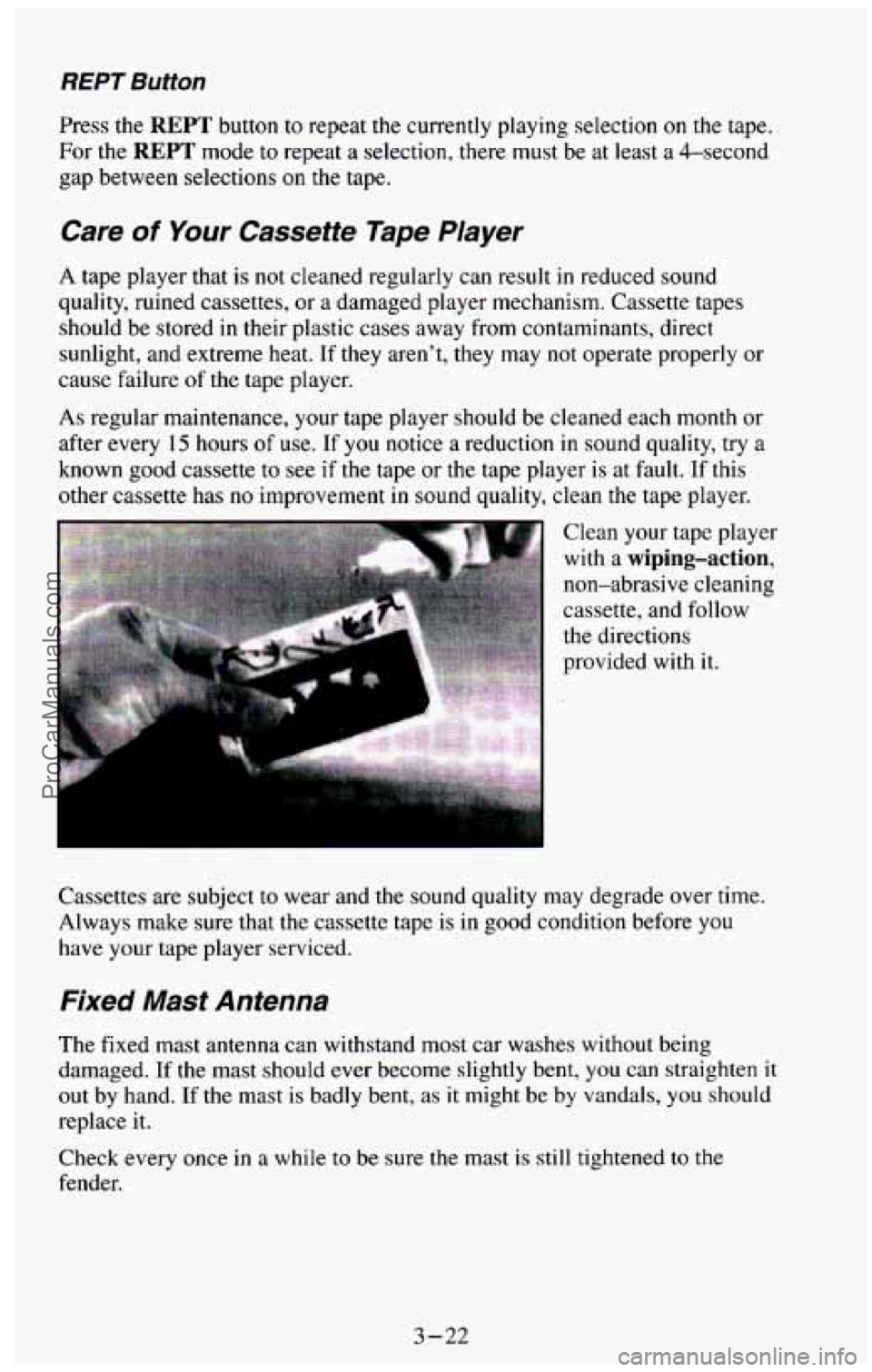
REPT Butfon
Press the REPT button to repeat the currently playing selection on the tape.
For the
REPT mode to repeat a selection, there must be at least a 4-second
gap between selections on the tape.
Care of Your Cassette Tape Player
A tape player that is not cleaned regularly can result in reduced sound
quality, ruined cassettes, or a damaged player mechanism. Cassette tapes
should be stored in their plastic cases away from contaminants, direct
sunlight, and extreme heat. If they aren’t, they may not operate properly or
cause failure
of the tape player.
As regular maintenance, your tape player should be cleaned each month or
after every
15 hours of use. If you notice a reduction in sound quality, try a
known good cassette to see
if the tape or the tape player is at fault. If this
other cassette has
no improvement in sound quality, clean the tape player.
Clean your tape player
with a wiping-action,
non-abrasive cleaning
cassette, and follow
the directions
provided with it.
Cassettes are subject to wear and
the sound quality may degrade over time.
Always make sure that the cassette tape is in
good condition before you
have your tape player serviced.
Fixed Mast Antenna
The fixed mast antenna can withstand most car washes without being
damaged.
If the mast should ever become slightly bent, you can straighten it
out by hand. If the mast is badly bent, as it might be by vandals, you should
replace it.
Check every once
in a while to be sure the mast is still tightened to the
fender.
3-22
ProCarManuals.com
Page 171 of 385
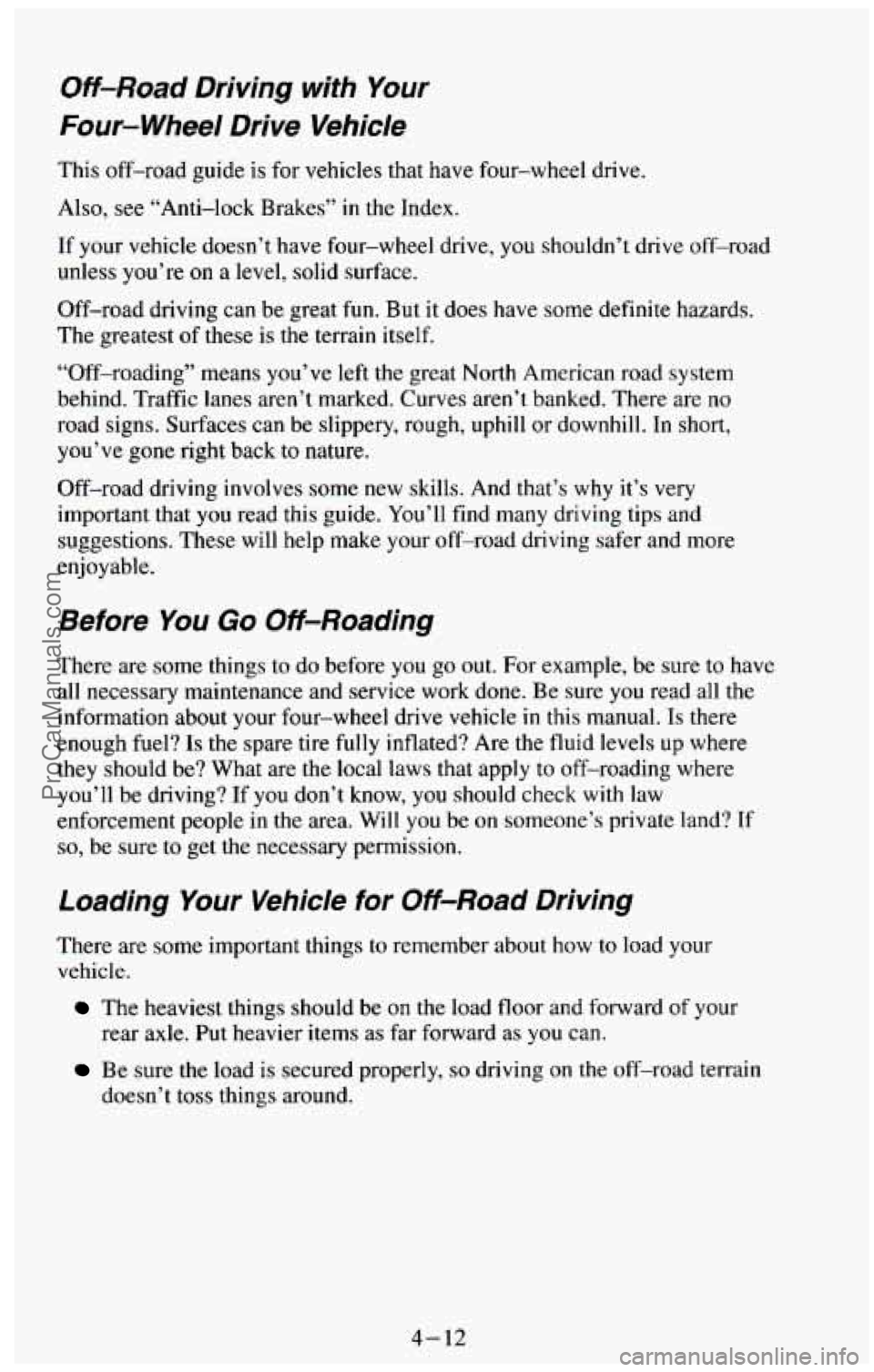
Off-Road Driving with Your
Four- Wheel Drive Vehicle
This off-road guide is for vehicles that have four-wheel drive.
Also, see “Anti-lock Brakes”
in the Index.
If your vehicle doesn’t have four-wheel drive, you shouldn’t drive off-road
unless you’re
on a level, solid surface.
Off-road driving
can be great fun. But it does have some definite hazards.
The greatest of these is the terrain itself.
“Off-roading” means you’ve left the great North American road system
behind. Traffic lanes aren’t marked. Curves aren’t banked. There are no
road signs. Surfaces can be slippery, rough, uphill or downhill. In short,
you’ve gone right back
to nature.
Off-road driving involves some new skills. And that’s
why it’s very
important that you read this guide. You’ll find many driving tips and
suggestions. These will help make your off-road driving safer and more
enjoyable.
Before You Go Off-Roading
There are some things to do before you go out. For example, be sure to have
all necessary maintenance and service work done. Be sure you read
all the
information about your four-wheel drive vehicle
in this manual. Is there
enough fuel?
Is the spare tire fully inflated? Are the fluid levels up where
they should be? What are the local laws that apply to off-roading where
you’ll be driving? If you don’t know, you should check
with law
enforcement people in the area. Will you be on someone’s private land? If
so, be sure to get the necessary permission.
Loading Your Vehicle for Off-Road Driving
There are some important things to remember about how to load your
vehicle.
The heaviest things should be on the load floor and forward of your
Be sure the load is secured properly, so driving on the off-road terrain
rear axle.
Put heavier items as far forward as you can.
doesn’t toss things around.
4-12
ProCarManuals.com
Page 182 of 385
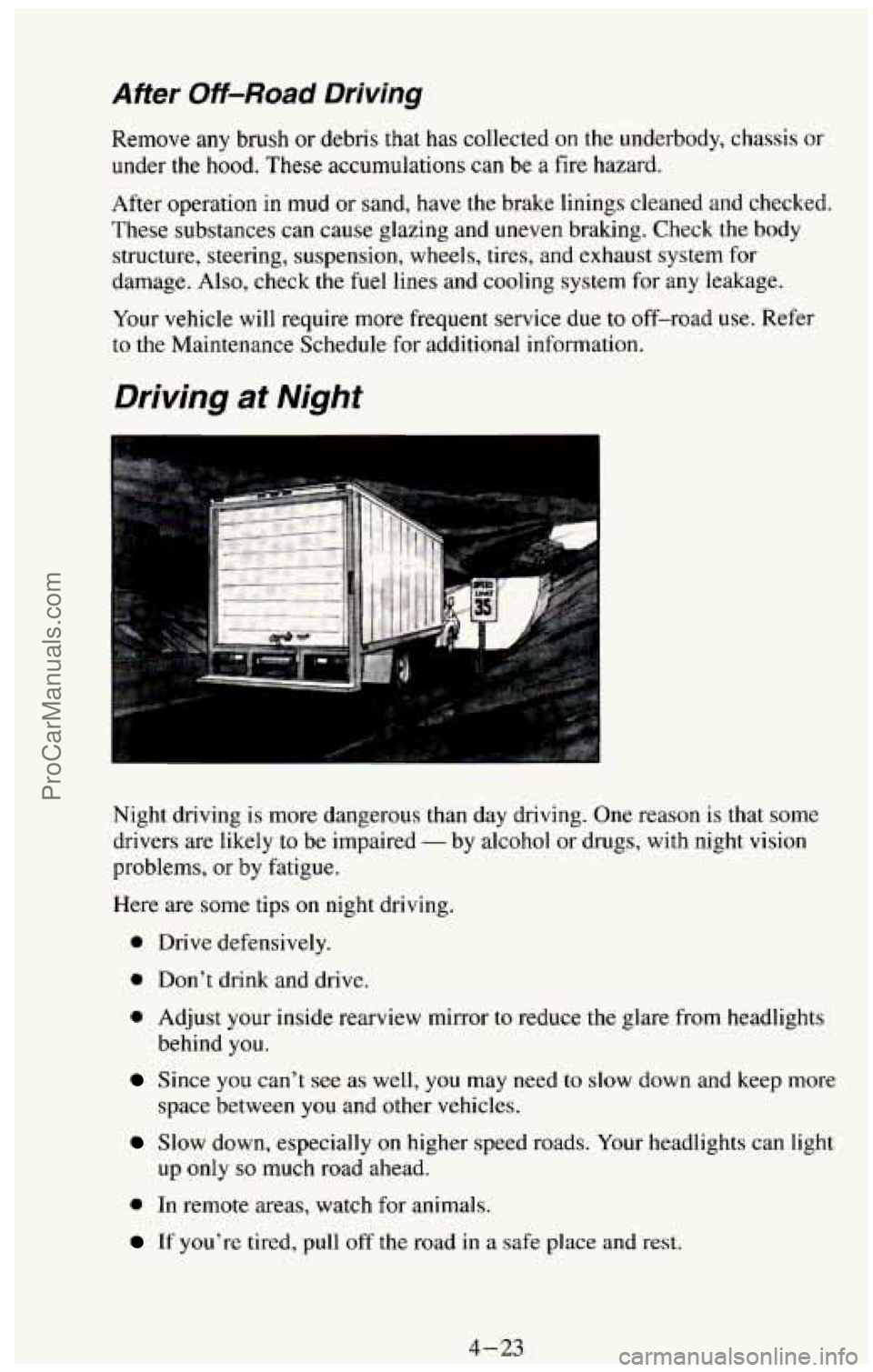
After Off-Road Driving
Remove any brush or debris that has collected on the underbody, chassis or
under the hood. These accumulations can be a fire hazard.
After operation in mud or sand, have the brake linings cleaned and checked.
These substances can
cause glazing and uneven braking. Check the body
structure, steering, suspension, wheels, tires, and exhaust system for
damage. Also, check the fuel lines and cooling system for any leakage.
Your vehicle will require more frequent service due to off-road use. Refer
to the Maintenance Schedule for additional information.
Driving at Night
Night driving is more dangerous than day driving. One reason is that some
drivers are likely
to be impaired - by alcohol or drugs, with night vision
problems, or by fatigue.
Here are some tips
on night driving.
0 Drive defensively.
0 Don't drink and drive.
0 Adjust your inside rearview mirror to reduce the glare from headlights
behind
you.
Since you can't see as well, you may need to slow down and keep more
space between you and other vehicles.
up
only so much road ahead.
Slow down, especially on higher speed roads. Your headlights can light
0 In remote areas, watch for animals.
If you're tired, pull off the road in a safe place and rest.
4-23 ProCarManuals.com
Page 203 of 385
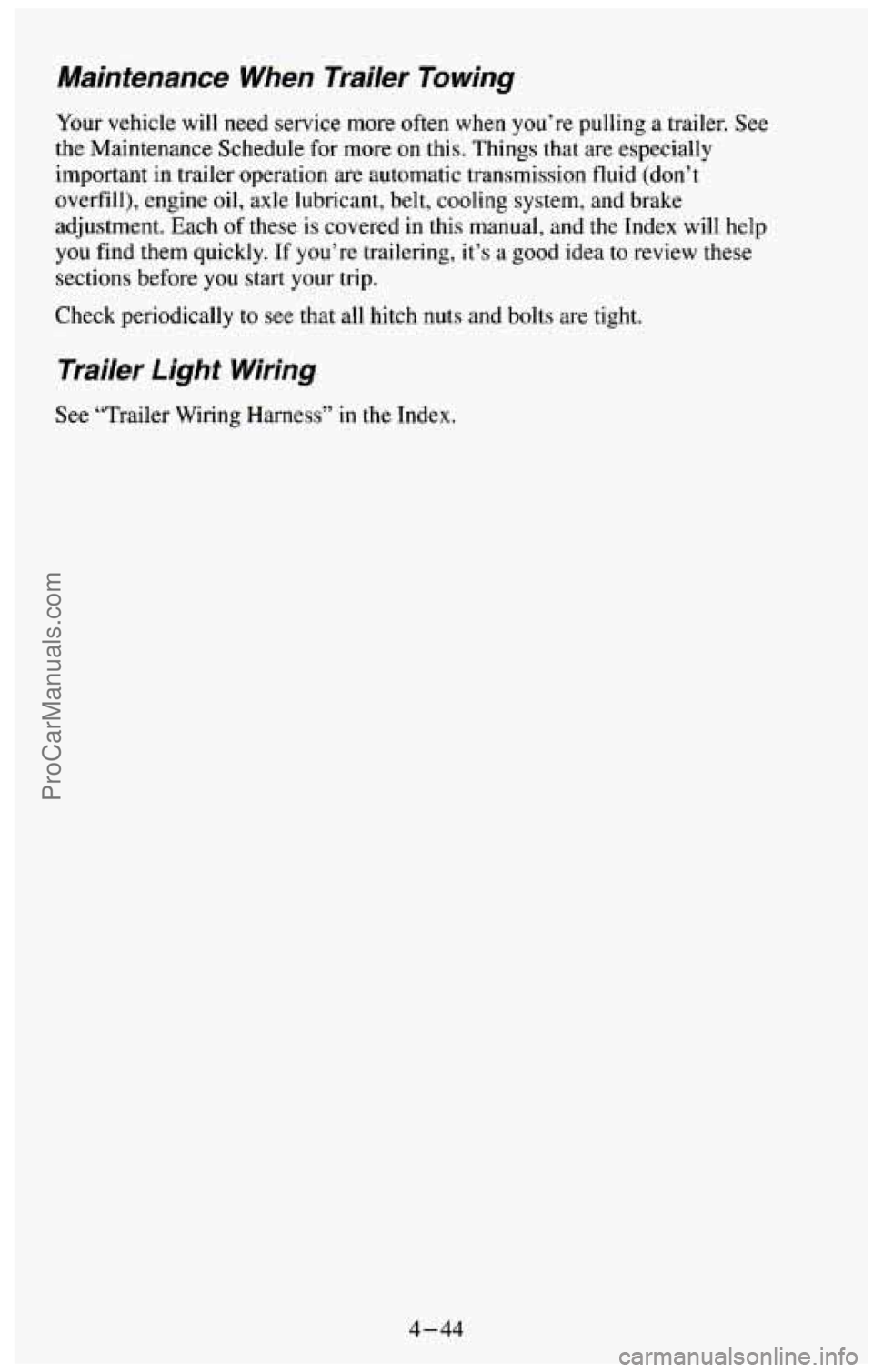
Maintenance When Trailer Towing
Your vehicle will need service more often when you’re pulling a trailer. See
the Maintenance Schedule for more on this. Things that are especially
important in trailer operation are automatic transmission fluid (don’t
overfill), engine oil, axle lubricant, belt, cooling system, and brake
adjustment. Each
of these is covered in this manual, and the Index will help
you find them quickly. If you’re trailering, it’s a good idea to review these
sections before you start your trip.
Check periodically to see
that all hitch nuts and bolts are tight.
Trailer Light Wiring
See “Trailer Wiring Harness” in the Index.
4-44
ProCarManuals.com
Page 247 of 385
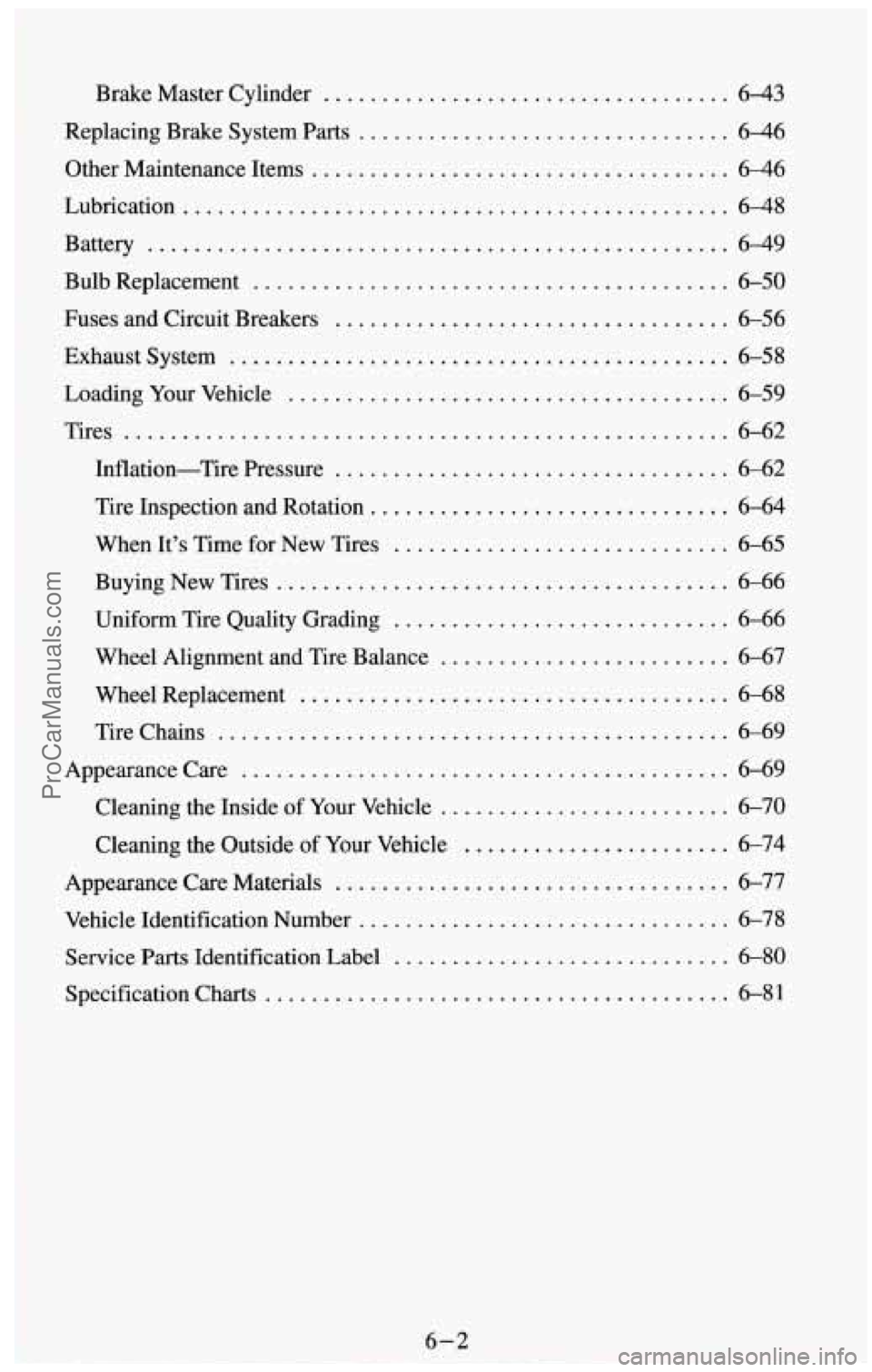
......................
................
Brake Master Cylinder ................................... 6-43
Replacing Brake System Parts .............................. 6-46
Other Maintenance Items .................................... 646
Lubrication ............. ..... 648
Battery ................ ....... 6-49
Bulb Replacement ......................................... 6-50
Fuses and Circuit Breakers ................................ 6-56
Exhaust System ....................................... 6-58
Loading Your Vehicle ...................................... 6-59
Tires .................................................... 6-62
Inflation-Tire Pressure .................................. 6-62
Tire Inspection and Rotation ............................... 6-64
When It’s Time for New Tires ......................... 6-65
Buying New Tires ..................................... 6-66
Uniform Tire Quality Grading ............................. 6-66
Wheel Alignment and Tire Balance ......................... 6-67
Wheel Replacement ..................................... 6-68
Tire Chains ............................................ 6-69
Appearancecare .......................................... 6-69
Cleaning the Inside of Your Vehicle ......................... 6-70
Cleaning the Outside of Your Vehicle ..................... 6-74
Appearance Care Materials .................................. 6-77
Vehicle Identification Number .............................. 6-78
Service Parts Identification Label ............................. 6-80
Specification Charts ...................................... 6-81
6-2
ProCarManuals.com
Page 248 of 385
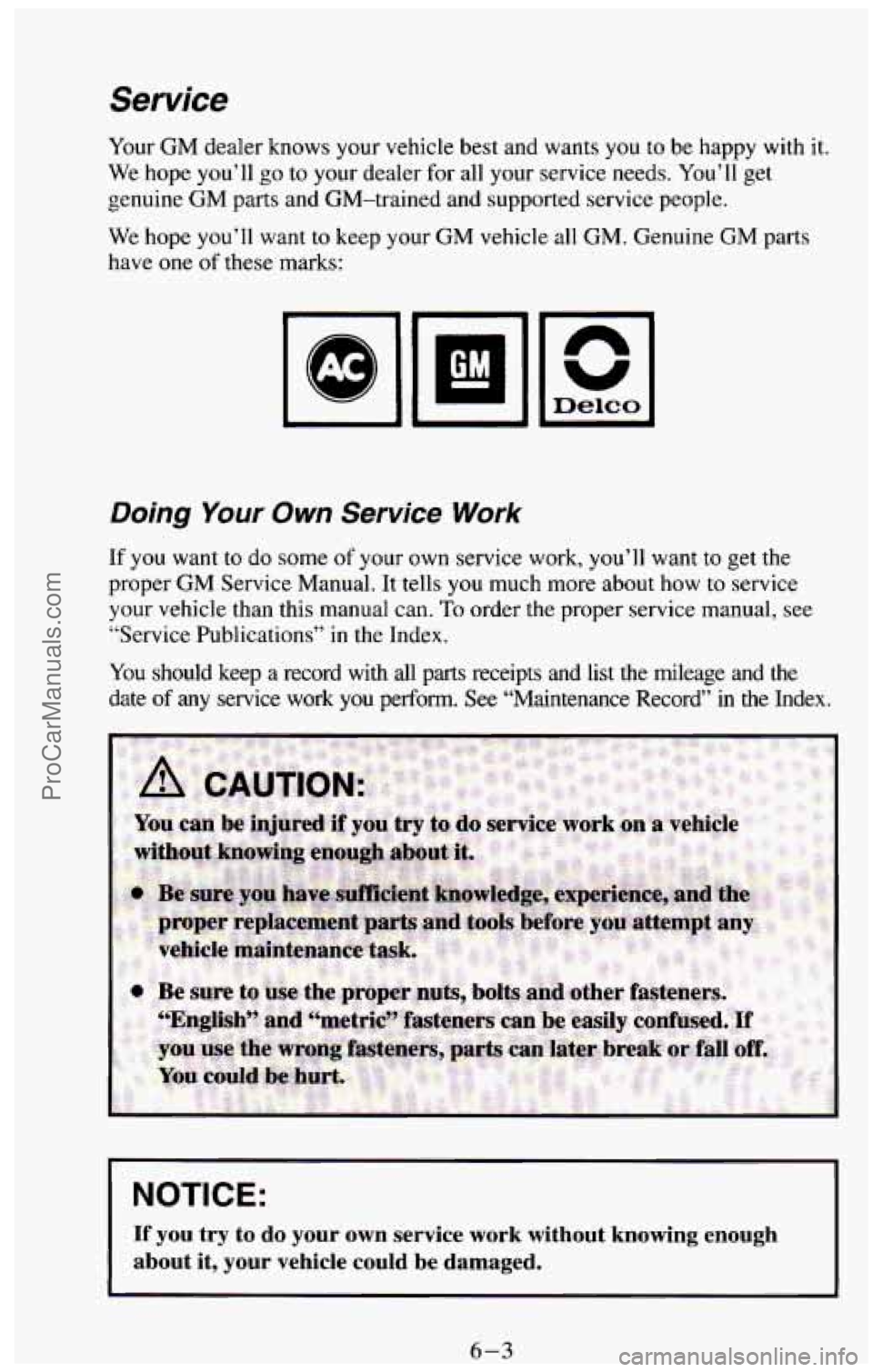
Service
Your GM dealer knows your vehicle best and wants you to be happy with it.
We hope you’ll go to your dealer for all your service needs. You’ll get
genuine GM parts and GM-trained and supported service people.
We hope
you’ll want to keep your GM vehicle all GM. Genuine GM parts
have one
of these marks:
Doing Your Own Service Work
If you want to do some of your own service work, you’ll want to get the
proper GM Service Manual. It tells you much more about how
to service
your vehicle than this manual can.
To order the proper service manual, see
“Service Publications”
in the Index.
You should keep a record with all parts receipts and list the mileage and the
date of
any service work you perform. See “Maintenance Record” in the Index.
I NOTICE:
I
If you try to do your own service work without knowing enough
about it, your vehicle could be damaged.
6-3 ProCarManuals.com
Page 249 of 385

Maintenance Schedule
Section 7 of this manual, “Scheduled Maintenance Services”, explains the
maintenance your new vehicle needs, and when
it should be done. It also
has a form that you can
use to record the maintenance work done on your
vehicle. Be sure to read this information.
Fuel (Gasoline Engine)
If your vehicle has a diesel engine, see “Diesel Fuel Requirements and Fuel
System” in this Section. For vehicles with gasoline engines, please read this.
Use regular unleaded gasoline rated at
87 octane or higher. It should meet
specifications ASTM
D4814 in the U.S. and CGSB 3.5-92 in Canada.
These fuels should have the proper additives,
so you should not have to add
anything to the
fuel.
In the U.S. and Canada, it’s easy to be sure you get the right kind of
gasoline (unleaded). You’ll see
“UNLEADED” right on the pump. And only
unleaded nozzles will fit into your vehicle’s filler neck.
Be sure the posted octane
is at least 87. If the octane is less than 87, you
may get a heavy knocking noise when you drive. If it’s bad enough, it can
damage your engine.
If you’re using fuel rated
at 87 octane or higher and you still hear heavy
knocking, your engine needs service. But don’t worry
if you hear a little
pinging noise when you’re accelerating or driving up
a hill. That’s normal
and
you don’t have to buy a higher octane fuel to get rid of pinging. It’s the
heavy, constant knock that means
you have a problem.
What about gasoline with blending materials that contain oxygen
(oxygenates), such
as MTBE or alcohol?
MTBE is “methyl tertiary-butyl ether.” Fuel that is no more than
15% MTBE is fine for your vehicle.
Ethanol is ethyl or grain alcohol. Properly-blended fuel that is no more than
10% ethanol is fine for your vehicle.
Methanol is methyl or wood alcohol.
NOTICE:
Fuel that is more than 5 % methanol is bad for your vehicle.
Don’t use it.
It can corrode metal parts in your fuel system and
also damage plastic and rubber parts. That damage wouldn’t be
covered under your warranty. And even at
5% or less, there
must
be “cosolvents” and corrosion preventers in this fuel to
help avoid these problems.
6-4
ProCarManuals.com